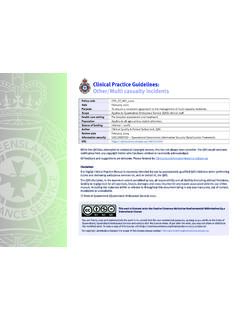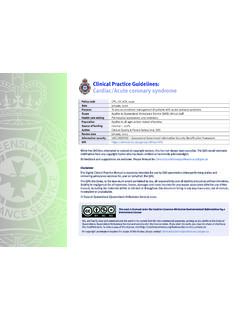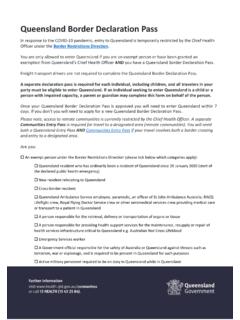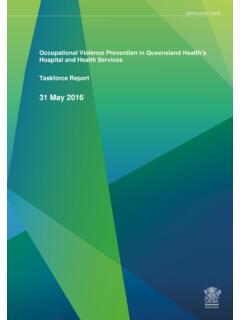Transcription of Clinical Practice Guidelines: Resuscitation/General guidelines
1 While the QAS has attempted to contact all copyright owners, this has not always been possible. The QAS would welcome notification from any copyright holder who has been omitted or incorrectly acknowledged. All feedback and suggestions are welcome. Please forward to: The Digital Clinical Practice Manual is expressly intended for use by appropriately qualified QAS clinicians when performing duties and delivering ambulance services for, and on behalf of, the QAS. The QAS disclaims, to the maximum extent permitted by law, all responsibility and all liability (including without limitation, liability in negligence) for all expenses, losses, damages and costs incurred for any reason associated with the use of this manual, including the materials within or referred to throughout this document being in any way inaccurate, out of context, incomplete or unavailable.
2 State of queensland ( queensland ambulance Service) codeCPG_RS_RGG_0221 DateFebruary, 2021 PurposeTo provide general guidelines for the consistent management to queensland ambulance Service (QAS) Clinical care settingPre-hospital assessment and to all ages unless stated of fundingInternal 100%AuthorClinical Quality & Patient Safety Unit, QASR eview dateFebruary, 2024 Information securityUNCLASSIFIED queensland Government Information Security Classification Practice guidelines : Resuscitation/General guidelinesThis work is licensed under the Creative Commons Attribution-NonCommercial-NoDerivatives International LicenseYou are free to copy and communicate the work in its current form for non-commercial purposes, as long as you attribute the State of queensland , queensland ambulance Service and comply with the licence terms.
3 If you alter the work, you may not share or distribute the modified work. To view a copy of this license, visit copyright permissions beyond the scope of this license please contact: ambulance SERVICER esuscitation General guidelinesCommencement of cardio-pulmonary resuscitationIn cases of cardio-pulmonary arrest, cardio-pulmonary resuscitation (CPR) must be commenced in accordance with the relevant guidelines set out in the following Clinical Practice guidelines (CPG) unless authorisation to withhold CPR has been confirmed (see below withholding CPR ): CPG: Resuscitation/Resuscitation Adult CPG: Resuscitation/Resuscitation Newly born CPG: Resuscitation/Resuscitation Paediatric CPG: Resuscitation/Special circumstances CPG.
4 Resuscitation/TraumaticThe QAS Clinical Consultation and Advice Line must be contacted no later than 15 minutes from commencement of QAS administered CPR for case specific Clinical management advice in the following patient cohorts: patients less than 18 years of age Hypothermia (temperature less than 32 C) Suspected toxicology/toxinology cause Post QAS fibrinolysis administration Pregnancy (clinically apparent) STEMI diagnosed by 12-Lead ECG prior to cardiac arrest Suspected pulmonary embolism (PE) Evidence of CPR induced , 2021 Figure Using bystanders to perform CPRIn some circumstances it may be appropriate to use bystanders to perform cardiac compressions. This can assist ambulance clinicians by allowing them to perform other Clinical tasks required for the patient, especially when there is only a single responder or single crew on a bystander is providing assistance, the ambulance clinician must ensure that the bystander is: able and willing to assist in performing cardiac compressions.
5 And suitably trained or able to demonstrate appropriate techniqueunder QAS guidance and assisting with CPR must be provided with personal protective equipment (PPE) that is appropriate in the cardio-pulmonary resuscitationIt is appropriate to withhold CPR in any of the following circumstances: Where the patient is exhibiting obvious signs of death such as:-decomposition;-putrefaction-hypostas is; and/or-rigor mortisUNCONTROLLED WHEN PRINTED UNCONTROLLED WHEN PRINTED UNCONTROLLED WHEN PRINTED UNCONTROLLED WHEN PRINTED222 queensland ambulance SERVICE(i) Patient Decision (Advance Health Directive)Life-sustaining measures can be withheld, or if commenced, immediately withdrawn, if the patient has made an Advance Health Directive giving direction to withhold or withdraw the specific life-sustaining measure that is required, and to do so in the precise Clinical circumstances that have : For a direction to withhold or withdraw a life-sustaining measure specified in the patient s Advance Health Directive to apply, the following CONDITIONS must first be satisfied.
6 The patient has impaired decision making capacity at the time the life-sustaining measure is required;[5] and There is no reasonable prospect that the patient will regain capacity to make decisions about health matters;[6] and The patient is suffering from one of the following conditions: [7]- a terminal illness or condition that is incurable or irreversible and, in the opinion of a doctor treating the patient, and one other doctor, the patient may reasonably be expected to die within one year;- a persistent vegetative state involving severe and irreversible brain damage;- permanently unconscious and has brain damage so severe that there is no reasonable prospect of the patient regaining consciousness; or- an illness or injury of such severity that there is no reasonable prospect of recovery.
7 Where the patient has sustained injuries that are totally incompatible with life such as:- decapitation;- cranial and cerebral destruction;- hemicorporectomy (or similar massive injury);- incineration;- foetal maceration. Where performing CPR may endanger the life, health or safety of the ambulance clinician. Where a lawful direction to withhold CPR has been provided to the ambulance clinician (see below).Withdrawing cardio-pulmonary resuscitation and other life-sustaining measuresCardio-pulmonary resuscitation and assisted ventilation are life-sustaining measures as defined in both the Powers of Attorney Act 1998 (Qld) and the Guardianship and Administration Act 2000 (Qld).A life-sustaining measure is health care intended to sustain or prolong life and supplants or maintains the operation of vital bodily functions that are temporarily or permanently incapable of independent operation.
8 [1]The Powers of Attorney Act 1998 and the Guardianship and Administration Act 2000 provide a legislative framework for decisions regarding life-sustaining measures, including decisions to withhold, or if commenced, to withdraw, cardio-pulmonary resuscitation, assisted ventilation, and other life-sustaining measures. The framework involves three possible pathways:(ii) A decision made by the patient s guardian or attorney [3](iii) A decision made by the patient s health provider in an acute emergency (see below for explanation of health provider for this purpose) [4](i) A decision made in advance by the patient in an Advance Health Directive [2]UNCONTROLLED WHEN PRINTED UNCONTROLLED WHEN PRINTED UNCONTROLLED WHEN PRINTED UNCONTROLLED WHEN PRINTED223 queensland ambulance SERVICEThe ambulance clinician should sight the original or a certified copy of the patient s Advance Health Directive and documentary evidence of, or be informed by the patient s treating medical practitioner, that the conditions (as set out in the Powers of Attorney Act and referred to above)
9 Have been satisfied.(ii) Patient s Attorney or Guardian s DecisionLife-sustaining measures can be withheld, or if commenced, immediately withdrawn, if the patient s tribunal appointed guardian or attorney (appointed health attorney or statutory health attorney) provides consent to withhold or withdraw the life-sustaining measure.[8]NOTE: Consent to withhold or withdraw life-sustaining measures provided by an attorney or guardian cannot operate unless the ambulance clinician reasonably considers that the commencement or continuation of the life-sustaining measure for the patient would, having regard for all the circumstances, be inconsistent with good medical Practice .[9] See below for definition of good medical Practice .
10 ambulance clinicians must consult with the QAS Clinical Consultation and Advice Line for direction if in doubt regarding whether the guardian or attorney s direction/consent to withhold or withdraw life-sustaining measures is consistent with good medical Medical PracticeDecisions to withhold or withdraw CPR and other life-sustaining measures that are made by the patient s attorney or guardian, and those made by the patient s health provider, MUST be consistent with good medical Practice . Good medical Practice is determined in the context of the patient s Clinical circumstances and the location of the patient at the Powers of Attorney Act 1998 and the Guardianship and Administration Act 2000 define good medical Practice as that which has regard for: the recognised medical standards, practices and procedures of the medical profession of Australia, and [10] the recognised ethical standards of the medical profession in Australia.












